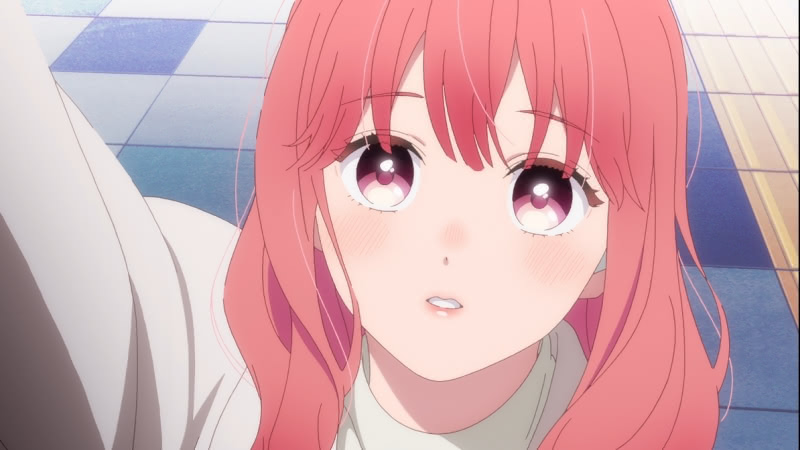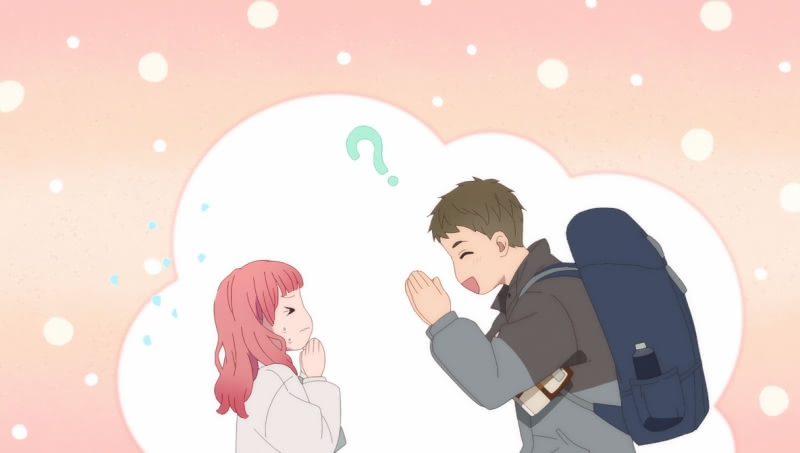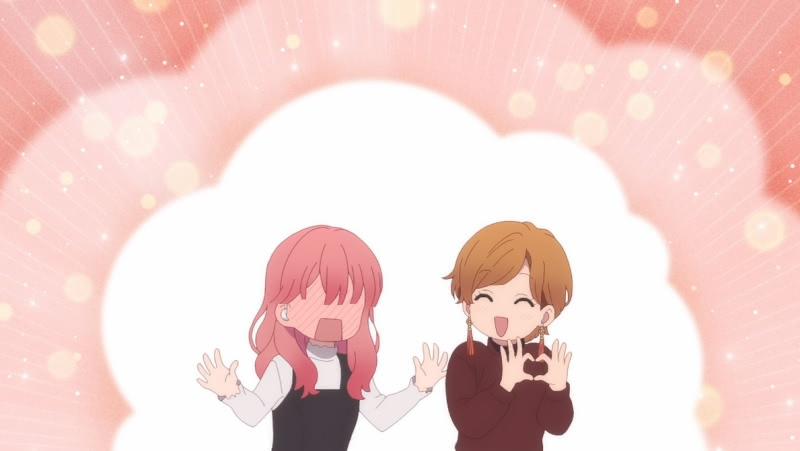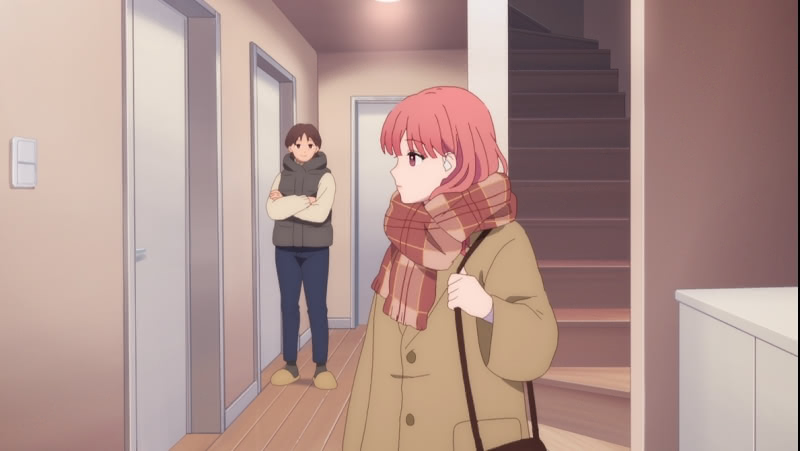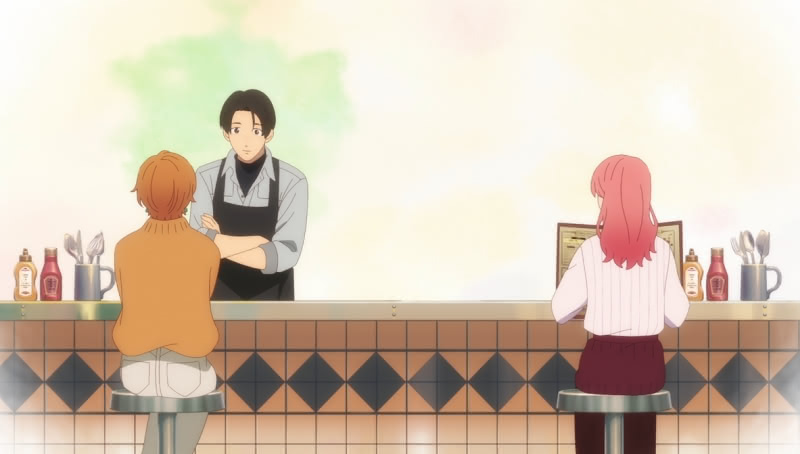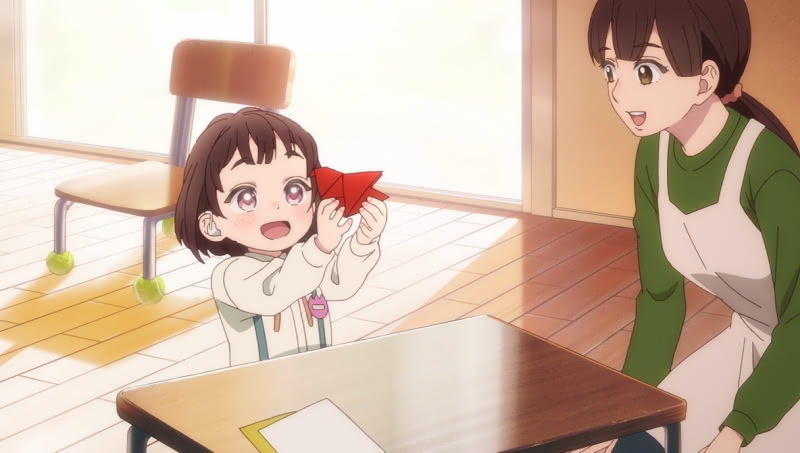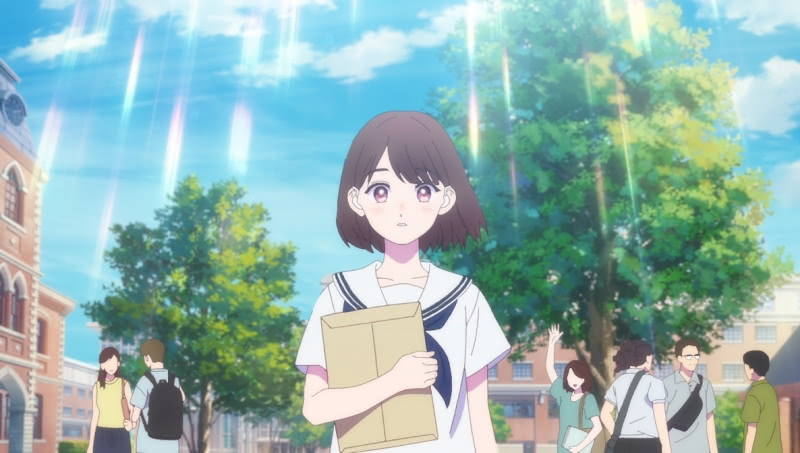2024 has begun in earnest, and with the new year comes new anime which I began as I was writing my review of the year that was in 2023. Some New Leaf Journal readers will know that I am possibly the internet’s leading 2D person hair color anthropologist (not to brag). It did not take long for a new 2024 anime series to deliver a colorful article topic. Today, we examine the changing hair color of the protagonist and heroine of A Sign of Affection, Yuki Itose.
(See my full collection of posts on hair color in Japanese anime, manga, novels, and games.)
Brief Introduction to A Sign of Affection
(Prefatory non-spoiler note: I have only seen the first episodes of A Sign of Affection as of the date I published this article. While I read slightly further than that in the manga several years ago, I do not discuss any events that take place beyond the second episode of the anime. While there are no major spoilers, consider yourself warned if you would prefer to watch the first two episodes before reading this hair color study.)
A Sign of Affection is a new 2024 anime series based on a manga series of the same name (Yubisaki to Renren). On the surface, it is a traditional shoujo romance where a down-to-Earth cute-but-apparently-normal girl falls in love with a tall, bold, attractive young man who happens to return her feelings. There are also many other tall attractive men in the series although it dispenses with any reverse-harem hijinks very quickly.
While A Sign of Affection has many ingredients for a traditional shoujo affair, the main character, the 19-year old college student Yuki Itose, has a distinguishing characteristic that is suggested by the series’ title: She is deaf. Yuki wears hearing aids, but by her account everything around her sounds muffled. She relies on sign-language and lip-reading to communicate. The young man of her dreams, Itsuomi Nagi, loves traveling and learning languages. (Aside: His voice actor, Mr. Ashioki Ōshi, does a very good job with English by anime standards.) This young man who travels the world quickly falls for the shy Yuki and takes an interest in learning sign language from her.
A Sign of Affection represents a rare case where I was somewhat familiar with the source material before watching the anime (I generally do not read manga). I had a free Kindle Unlimited subscription back in late 2018 and early 2019 after I upgraded my Kindle Paperwhite (I paid for it for a few months after my free period expired). A Sign of Affection saw some of its early chapters come over in English while I still had my subscription. While I did not read deeply into the series or keep up with it, I read the chapters that made up a decent chunk of what the first season is covering (episode 4 is not beyond what I had read). I thought it was decent but unremarkable in manga form.
I have a generally positive impression of the first four episodes of the anime, despite some shoujo excesses (Itsuomi is too oblivious of personal space, even in context, and Ōshi’s surly over-protectiveness veers into caricature territory) and other hiccups. The material is elevated by the anime’s exceptional aesthetics, which include animation that is well-above average and some terrific use of colors. The voice acting is also good and while I do think it could do more to help the viewer see the world from Yuki’s perspective, it does more than the minimum in that area. I have reason to believe from my prior exposure to the series that it will cut to the point much faster than most shoujo series, and I am cautiously optimistic that we will see some interesting character development for both Yuki and Itsuomi in the anime’s second half.
Yuki Itose’s Hair Color
Before interpreting hair color in anime, we must first understand the anime’s setting. A Sign of Affection has a real-world Japan setting. All of the main characters are college students or young working adults. The series is entirely down-to-Earth and realistic aside from its mildly oppressive shoujo-ness.
With the setting out of the way, I introduce the subject of this article, Ms. Yuki Itose, in her first on-screen appearance in A Sign of Affection’s opening scene:
Yuki’s hair color defies easy description. It is some shade of pink or red. I will go with light strawberry. Regardless of how you describe it, it is clear that Yuki’s hair color is not likely to occur naturally in a Japanese person.
While the opening episode does not explicitly comment on Yuki’s hair or any characters using hair dye, it gives us some things to chew on. My anime hair color analysis pieces almost always focus on Japanese characters (the exceptions thus far have examined Chinese characters: See my articles on The Apothecary Diaries and The Raven of the Inner Palace). Yuki is Japanese. But in an early scene, she meets an American on the train asking for directions in English.
Poor Yuki. She usually relies on lip-reading, but she does not know English – so she is lost when the American man asks her if she speaks English. But I included the screen capture because it shows us how A Sign of Affection depicts an American with brown hair and how it compares to Yuki’s unusual hair color.
Yuki is quickly rescued by her soon-to-be love interest, Itsuomi, who does speak English. But we are not interested with Itsuomi’s impressive mastery of multiple languages or his tendency to disregard personal space (fortunately for him, Yuki is a true shoujo heroine so it is all good). But the latter point is relevant to the next screenshot:
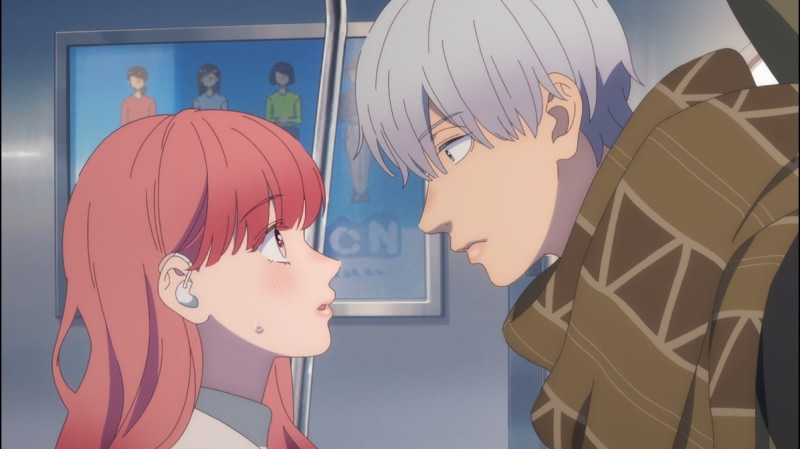
Itsuomi has silver-white hair. It stands out even more than Yuki’s hair color. The introductions keep coming. Next we meet Yuki’s over-protective childhood friend, Ōshi Ashioki, seen procuring bread while Yuki runs by in the background.
Ōshi has black hair. No surprises here. But as we will see, that makes him stand out from the rest of the main cast. Yuki’s best friend in college, Rin Fujishiro, appears to have hair in the light golden brown neighborhood. Were one to see it in nature, one would think dyed.
We continue with our evidence collecting at Yuki’s home. Not only does college student Yuki live at home, but we learn she has a curfew. The curfew will actually be relevant to our hair color research – but not yet. For now let us have a look at Yuki with her mother:
Seeing a character’s parent or sibling can be instructive for understanding hair color (I used this approach in my analysis of The Girl I Like Forgot Her Glasses). Yuki’s mother has dark brown hair – dark enough that it can be understood as natural for a Japanese person in the anime context. It is very clearly distinct from Yuki’s hair color. The clues are piling up that Yuki dyed her hair, but we are still left with clues.
We meet one more major character in the opening episode, Itsuomi’s older cousin, Kyōya Nagi.
Kyōya has plausibly natural hair – and he stands out from Yuki and Rin. At a minimum, we learn that white-silver hair does not run in the Nagi family.
We often have to wait until late in a series for a dramatic hair color revelation. You may be wondering how long this article is going to be after I spent all that time on the first episode. However, part of why I spent all that time on the first episode is because A Sign of Affection drops a bomb on us in the second episode. Neither Yuki or Itsuomi confesses yet, but we do learn about Yuki’s hair. There is no mention of hair color or hair dye. A Sign of Affection fittingly – given that the title references sign language – opts for a show-instead-of-tell approach to the reveal. The second episode ends with Yuki narrating a flashback to her life before college. While the flashback – which shows Yuki attending a school for the deaf with a very small class and dreaming about attending a mainstream school (which she does for the first time in college), our focus here is narrow. We are studying hair color.
First, see a very young Yuki:
Yuki had dark brown hair as a small child. Her hair did not change in elementary school.
Nor did it change in high school.
Now compare younger Yuki’s hair to her mother’s hair:
I dare say the hair colors are just about identical.
While A Sign of Affection does not explicitly discuss hair color in its first two episodes, the difference between college-aged Yuki’s reddish hair and younger Yuki’s dark brown hair is stark. That younger Yuki had the same hair color as her mother seems to establish clearly and beyond doubt that Yuki dyes her hair in college. Moreover, the fact that Yuki dyes her hair gives us a paradigm to understanding other characters with unnatural (or at a minimum, unlikely) hair colors. Itsuomi and Rin almost certainly dye their hair, and we can say the same with regard to Itsuomi’s bleach-blonde friend, Shin Iryū, who is introduced in the next episode (see my later discussion of Shin).
Possible Relevance of Yuki’s Hair Color to the Story
It is not always the case that a character’s unusual or unnatural hair color is relevant to an anime’s story. For example, my first hair color article covered the case of Oregairu’s Iroha Isshiki, who is noted to have natural light brown hair despite being Japanese. But there is no indication that anyone treats Iroha differently because of her unusual natural hair color. Conversely, Anna Nagumo of Ippon! Again had suffered some hardship in gym class due to a teacher’s wrongly believing that she dyed her hair brown. In the case of A Sign of Affection, it is clear that Yuki’s decision to dye her hair is not unusual in the context of a student at her college. We see that a number of her classmates also dye their hair, and Itsuomi’s white hair is more striking than Yuki’s reddish-brown color choice. But I do think that Yuki’s decision to dye her hair is likely fits in with her backstory.
Before continuing, note that I have only seen the first four episodes of A Sign of Affection and almost all of the analysis I will offer below is based on the first two episodes. To the extent this analysis includes spoilers – it only covers things that we learn in the first two episodes. While I think that my assessment is is sound based on the first two episodes, I am sure that the series will go into more detail about Yuki’s character in later episodes.
The first episode reveals that Yuki’s mother imposes a curfew on her. This makes her different than all of the other characters we are introduced to. For example, Itsuomi lives alone and regularly travels abroad. Rin is clearly not bound by a curfew. Yuki’s over-protective (and irritating) childhood friend, Ōshi, seems to think that Yuki cannot fend for herself at all – going so far as to ask her point blank why she had to go to college (she was spared having to answer by a fortuitous Itsuomi appearance). Despite being mostly independent at school, Yuki has to rely on Rin to take notes for her in class.
While Yuki does not display any obvious dissatisfaction with her situation, there are signs in the first two episodes that she is striving for independence. In her flashback, she explained that she attended the same school for the deaf from nursery school through high school and spent the entire time as part of a four-person class of deaf students. She noted that everyone was safe and kind and that it was her entire world. That is, Yuki has fond memories of those years she spent with a close-knit group. But then she stated:
And yet, I longed for more.
It was that longing that made her “hope[] to set foot into the outside world” and inspired her to apply for admission into a regular college.
As we know, Yuki was successful in her effort to make it into college. From all the evidence, I suspect that Yuki dyed her hair after she accepted the offer of admission to college. Just based on the early episodes, I will venture that Yuki dyed her hair for two reasons. Firstly, she may have seen it as a little change to go along with her big move from the small warm place that had been her “entire world” since she was a toddler (it is also possible that hair coloring was not permitted in her small old school). Secondly, dying her hair to a color that would stand out may have been a small declaration of independence for Yuki. She still had a curfew and her one friend outside of her core school group was annoyingly over-protective. Yuki would still need help at her new school. But she had taken her first step into the outside world (so to speak) and for the first time in her life, had some degree of independence.
I conclude with a serious note on one thing that I think A Sign of Affection has done well with respect to the Yuki flashback (I dare say it was one of the best short anime childhood flashback sequences I have seen on this side of 5 Centimeters Per Second). Yuki is only 19 years old, meaning that she is likely about one year removed from being part of a four-person class of deaf students. The flashback uses subtle visual clues along with Yuki’s narration to show that, despite having happened very recently, those warm days are already distant from Yuki’s presence. This is not because Yuki resents those quainter days, but instead because her world changed dramatically after entering college and is changing even more as she falls in love for the first time.
Conclusion
I look forward to continuing with A Sign of Affection, but as a 2D person hair color anthropologist, my first priority will be looking for clues or statements about Yuki’s hair pigmentation decisions for possible future New Leaf Journal research projects.
Updates: See my follow-up articles on Itsuomi’s hair color (from ep 5), hair color notes about both Yuki and Itsuomi in episode 7, the hair color of Shin and an additional character based on information in episode 8, and Itsuomi’s discussing the reason behind his silver hair color choice in episode 10.
